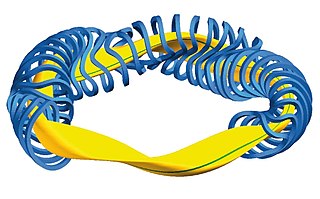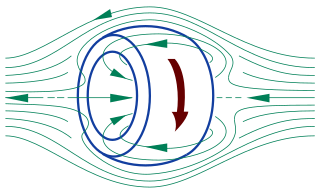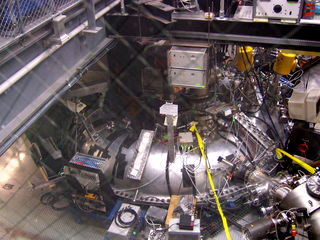
A stellarator is a device that confines plasma using external magnets. Scientists researching magnetic confinement fusion aim to use stellarator devices as a vessel for nuclear fusion reactions. The name refers to stars as fusion also occurs in stars such as the Sun. It is one of the earliest fusion power devices, along with the z-pinch and magnetic mirror.

A tokamak is a device which uses a powerful magnetic field generated by external magnets to confine plasma in the shape of an axially-symmetrical torus. The tokamak is one of several types of magnetic confinement devices being developed to produce controlled thermonuclear fusion power. The tokamak concept is currently one of the leading candidates for a practical fusion reactor.

In plasma physics, plasma stability concerns the stability properties of a plasma in equilibrium and its behavior under small perturbations. The stability of the system determines if the perturbations will grow, oscillate, or be damped out. It is an important consideration in topics such as nuclear fusion and astrophysical plasma.

Fusion power is a proposed form of power generation that would generate electricity by using heat from nuclear fusion reactions. In a fusion process, two lighter atomic nuclei combine to form a heavier nucleus, while releasing energy. Devices designed to harness this energy are known as fusion reactors. Research into fusion reactors began in the 1940s, but as of 2024, no device has reached net power, although net positive reactions have been achieved.

A reversed-field pinch (RFP) is a device used to produce and contain near-thermonuclear plasmas. It is a toroidal pinch which uses a unique magnetic field configuration as a scheme to magnetically confine a plasma, primarily to study magnetic confinement fusion. Its magnetic geometry is somewhat different from that of the more common tokamak. As one moves out radially, the portion of the magnetic field pointing toroidally reverses its direction, giving rise to the term reversed field. This configuration can be sustained with comparatively lower fields than that of a tokamak of similar power density. One of the disadvantages of this configuration is that it tends to be more susceptible to non-linear effects and turbulence. This makes it a useful system for studying non-ideal (resistive) magnetohydrodynamics. RFPs are also used in studying astrophysical plasmas, which share many common features.

Magnetic confinement fusion (MCF) is an approach to generate thermonuclear fusion power that uses magnetic fields to confine fusion fuel in the form of a plasma. Magnetic confinement is one of two major branches of controlled fusion research, along with inertial confinement fusion.

A field-reversed configuration (FRC) is a type of plasma device studied as a means of producing nuclear fusion. It confines a plasma on closed magnetic field lines without a central penetration. In an FRC, the plasma has the form of a self-stable torus, similar to a smoke ring.

A spheromak is an arrangement of plasma formed into a toroidal shape similar to a smoke ring. The spheromak contains large internal electric currents and their associated magnetic fields arranged so the magnetohydrodynamic forces within the spheromak are nearly balanced, resulting in long-lived (microsecond) confinement times without external fields. Spheromaks belong to a type of plasma configuration referred to as the compact toroids. A spheromak can be made and sustained using magnetic flux injection, leading to a dynomak.

The Madison Symmetric Torus (MST) is a reversed field pinch (RFP) physics experiment with applications to both fusion energy research and astrophysical plasmas.

The National Spherical Torus Experiment (NSTX) is a magnetic fusion device based on the spherical tokamak concept. It was constructed by the Princeton Plasma Physics Laboratory (PPPL) in collaboration with the Oak Ridge National Laboratory, Columbia University, and the University of Washington at Seattle. It entered service in 1999. In 2012 it was shut down as part of an upgrade program and became NSTX-U, for Upgrade.
The beta of a plasma, symbolized by β, is the ratio of the plasma pressure (p = nkBT) to the magnetic pressure (pmag = B²/2μ0). The term is commonly used in studies of the Sun and Earth's magnetic field, and in the field of fusion power designs.

In a toroidal fusion power reactor, the magnetic fields confining the plasma are formed in a helical shape, winding around the interior of the reactor. The safety factor, labeled q or q(r), is the ratio of the times a particular magnetic field line travels around a toroidal confinement area's "long way" (toroidally) to the "short way" (poloidally).

A spherical tokamak is a type of fusion power device based on the tokamak principle. It is notable for its very narrow profile, or aspect ratio. A traditional tokamak has a toroidal confinement area that gives it an overall shape similar to a donut, complete with a large hole in the middle. The spherical tokamak reduces the size of the hole as much as possible, resulting in a plasma shape that is almost spherical, often compared to a cored apple. The spherical tokamak is sometimes referred to as a spherical torus and often shortened to ST.
The Lockheed Martin Compact Fusion Reactor (CFR) was a fusion power project at Lockheed Martin’s Skunk Works. Its high-beta configuration, which implies that the ratio of plasma pressure to magnetic pressure is greater than or equal to 1, allows a compact design and expedited development. The project was active between 2010 and 2019, after that date there have been no updates and it appears the division has shut down.

Dynomak is a spheromak fusion reactor concept developed by the University of Washington using U.S. Department of Energy funding.

The Princeton field-reversed configuration (PFRC) is a series of experiments in plasma physics, an experimental program to evaluate a configuration for a fusion power reactor, at the Princeton Plasma Physics Laboratory (PPPL). The experiment probes the dynamics of long-pulse, collisionless, low s-parameter field-reversed configurations (FRCs) formed with odd-parity rotating magnetic fields. FRCs are the evolution of the Greek engineer's Nicholas C. Christofilos original idea of E-layers which he developed for the Astron fusion reactor. The PFRC program aims to experimentally verify the physics predictions that such configurations are globally stable and have transport levels comparable with classical magnetic diffusion. It also aims to apply this technology to the Direct Fusion Drive concept for spacecraft propulsion.
The Prairie View (PV) Rotamak is a plasma physics experiment at Prairie View A&M University. The experiment studies magnetic plasma confinement to support controlled nuclear fusion experiments. Specifically, the PV Rotamak can be used as either a spherical tokamak or a field-reversed configuration. Some time between 2015 and 2017, most personnel moved on to advanced career opportunities. In 2017, a Final Report to Department of Energy (DOE) was prepared and submitted by Dr. Saganti of PVAMU on the entire research work supported by DOE for 12 years.

The Compact Toroidal Hybrid (CTH) is an experimental device at Auburn University that uses magnetic fields to confine high-temperature plasmas. CTH is a torsatron type of stellarator with an external, continuously wound helical coil that generates the bulk of the magnetic field for containing a plasma.
The Tokamak Physics Experiment (TPX) was a plasma physics experiment that was designed but not built. It was designed by an inter-organizational team in the USA led by Princeton Plasma Physics Laboratory. The experiment was designed to test theories about how Tokamaks would behave in a high-performance, steady-state regime.













